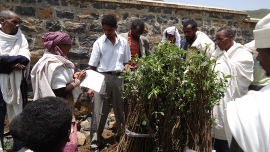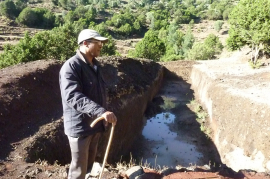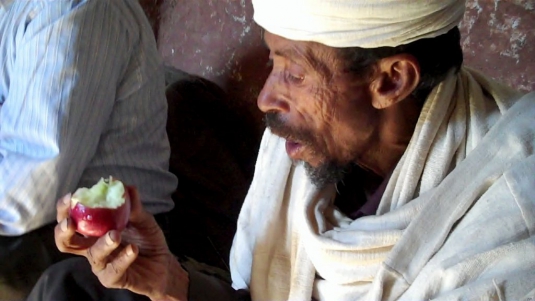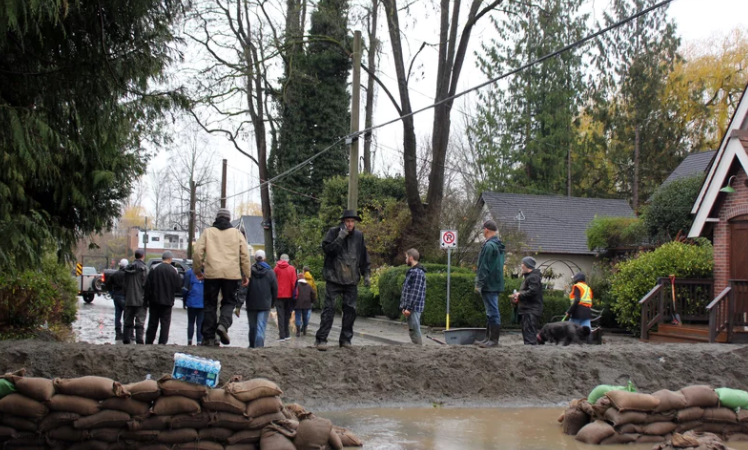Author: Shelly Sommer
The villagers of Atebes, in northern Ethiopia, harvested their first apple in February 2011. “The fruit was passed to everyone with feedback about its odor, its tenderness; and finally it was tasted,” says Research Associate Tsegay Wolde-Georgis. “They had never seen or tasted apple fruit before that day.”Wolde-Georgis, part of the INSTAAR program Consortium for Capacity Building (CCB), is leading a project to introduce the cultivation of apple trees irrigated by water-filled, buried clay pots to the mountainous, dry region of Atebes. The rainy season there lasts only two months (July and August). Over the last 30 years, land degradation and climate change have exacerbated existing constraints of drought, soil erosion, deforestation, poor food supply consisting entirely of cereal grains, and lack of access to water. The goal of the clay pot project is to improve the resiliency of the community to climate-related hazards through demonstration and capacity building. So far, the project has led not only to the cultivation of high-value fruits and vegetables, but to erosion control and improved water supplies. Wolde-Georgis made his first trip to Atebes, a village of about 4000 people, in July 2010. He met with community leaders, farmers, and students, who identified water supply as the main constraint on the community. Women and farmers traveled five kilometers to other ecosystems to find water and hand-carry it back to their homesteads in Atebes. Their initial interest in the project was more focused on water harvesting than on a new food supply. They chose a pilot site for the project.

A community effort from the beginning, the project split an initial supply of 300 apple saplings between farmers, students on vacation, and the pilot site. Farmers and students received training together; students dug holes for tree planting at the pilot site. Seven volunteers became trainers, learning how to plant and care for the seedlings. The volunteers led community members in locating planting sites, mixing soil and compost, and planting the trees. Clay pots traditionally made in the region were buried in soil and filled with water to serve as reservoirs; trees were planted around the pots in a mixture of soil and compost made from animal dung. The water-saving capacity of the clay pots is so effective that almost all the trees came alive through the dry season. While clay pots use water efficiently, lack of water was still the greatest obstacle to expanding fruit tree cultivation. Deforestation and erosion resulted in streams gashing deep gulleys in the land, carrying seasonal water supplies past the soil. According to village elders, streams that had once been perennial had dried up or become seasonal about 30 years ago.

Local project management has been essential to the project’s progress. Farmers have a committee to manage water distribution. Students water the plants in the pilot site. Volunteers are managing the newly revitalized streams. The community participated in all phases of project implementation. Support has come from the local governments, and the project is serving as a demonstration to other communities in the area. A graduate student at the Institute of Climate and Society, Makelle University, Tigray, Ethiopia, has proposed writing a master’s thesis on the use of clay pots for irrigation based on the project. Four years along, 1400 apple trees are planted in the village. Some of the dwarf varieties are already producing fruit. Households are growing vegetables using the clay pot method and planting vetiver grass for erosion control and a potential commercial crop. Streams that had been dry by the end of December now hold water through the end of May. Villagers are considering other avenues of environmental management.
See a gallery of photos from Atebes.
Funding for the project has come from the Conservation, Food and Health Foundation and from public support through a GlobalGiving fund. To contribute to the continuation of the project, donate through GlobalGiving. The somewhat shoestring budget has resulted in significant changes to life in Atebes. For instance, for decades weddings in Atebes were preceded by the women of the village walking for hours to carry water from distant sources to supply the gathering. Wolde-Georgis says, “Last year was the first wedding where no one brought water.” There was enough in local sources to provide for everyone at the celebration.



